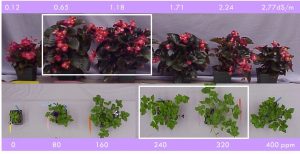Fertilizer Requirements of Greenhouse Plants: One Size Does not Fit All!
Dr. Krishna Nemali, Controlled Environment Agriculture Extension Specialist
Department of Horticulture & Landscape Architecture, Purdue University
Email: knemali@purdue.edu, Tel: 765-494-8179
Hope you are all getting busy in the greenhouses. I have been travelling around and finding that many growers generally use one fertilizer recipe for all crops. In this article, I want share my thoughts on the importance of adding the right amount of fertilizer for producing a quality crop. I put together the picture below, which I took several years back, to show you how fertilizer can affect plant quality. The pictures are from an experiment where wax begonias and petunias were grown in 4-inch containers and sub-irrigated daily with different fertilizer concentrations. Both ppm and EC values are shown for different fertilizer concentrations in the picture. The media did not contain any starter fertilizer. Plants were grown under 15 mol/m2/day light level and with best management practices!

You can clearly see how fertilizer concentration can affect crop growth. Two things are important to note here. First, one recipe does not fit all crops. Wax begonias seem to do very well between EC levels of 0.65 to 1.18 dS/m while petunias needed a higher EC (1.71 to 2.24 dS/m) under sub-irrigation. Second, adding less or more fertilizer than optimum reduced plant quality in both species. Wax begonias were more sensitive to higher fertilizer concentration than petunia. Why? Generally, species with a slow growth habit is more sensitive to high fertilizer concentration than a fast growing species. The effects of high fertilizer concentration in the media are similar to what drought stress does to plants. When fertilizer salts are concentrated in the media, it becomes harder for plants to uptake water from the media similar to the drought situation. Now imagine a situation where you are growing wax begonias and petunias together. Certainly you do not want to feed them with the same recipe. I know that it can be quite challenging to manage different recipes for different species with a fertilizer injector. Perhaps the middle ground is to separate plants in the greenhouse into at least two groups (fast and slow growing) and feed them on different days with two different recipes. Remember plants in this experiment were sub-irrigated. You may be adding fertilizer using an overhead irrigation system. In that case, consider increasing EC by 0.5 dS/m as there will be leaching in overhead irrigation. Also note the conversions: 1 dS/m = 1 mS/cm = 1000 μS.